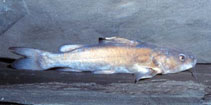| Family: |
Claroteidae (Claroteid catfishes), subfamily: Claroteinae |
| Max. size: |
65 cm SL (male/unsexed) |
| Environment: |
demersal; freshwater; depth range - 3 m, potamodromous |
| Distribution: |
Africa: Senegal to Cabinda, Angola (Ref. 3236, 81642). To the north also reported from Mauritania (Ref. 55783), southwards down to the lower Congo River (Ref. 1879) and Angolan coastal rivers (Ref. 120641). |
| Diagnosis: |
Dorsal spines (total): 2-2; Dorsal soft rays (total): 6-6; Anal spines: -0. Diagnosis: recognized by its pointed snout, the rather small mouth, and the width of the premaxillary tooth plate (1/5-1/3.5, usually 1/4, of head length); vomerine dentition represented by a square to rectangular tooth plate which begins to develop at sizes between 60 and 70 mm standard length; palatine dentition developing at sizes over 100 mm standard length, initially as isolated teeth; second or third branched dorsal-fin ray always the longest; upper caudal-fin lobe much longer than lower lobe; gill rakers long and smooth; other characters, such as length of dorsal fin, number of branched rays in anal fin, and number of gill rakers on first gill arch, are subject to intraspecific variations; sexually mature males and (some) ripe females show considerable morphological differences; such specimens have often been labelled as Chrysichthys furcatus; maturity occurs probably at a rather advanced stage (at over 200 mm SL) and leads to the inflation of head, broadening of mouth and premaxillary tooth plate, shortening of spines and overgrowth of fin-spines by thick skin, the fins becoming more rounded, and the caudal-fin lobes sometimes becoming subequal; the body acquires an emaciated, thinned down appearance (Ref. 57126, 81642). Characters only clear in mature males in
reproduction: adipose fin short, base contained 8-11 times in SL and measuring 28-64% of distance between dorsal fin and adipose fin; maxillary barbel not reaching beyond dorsal spine when extended; head swollen; skin mucous; spines thick and covered with skin (Ref. 81642).
Description: nasal barbels present; very short first dorsal spine; well developed second spine, weakly denticulate along posterior margin; pelvic fin with 1 unbranched and 5 branched soft rays (Ref. 57126). Anal fin with 3-7 unbranched and 8-12 branched soft rays (Ref. 57126, 81642). Post-cleithral process well developed (Ref. 75075). In the Sanaga River (Cameroon), close to the Nachtigal waterfalls, the dorsal fin is very long (length 30-40% SL versus 15-30% normally); the species then resembles C. longidorsalis from which it is distinguished by its more pointed snout, the presence of vomerine teeth and a smaller occipital process (Ref. 81642).
Coloration: live specimens greyish-silvery, but may become black under stress; preserved specimens dark brown on head and back, and white on belly; adipose fin often blackish; black spot behind gill cover very distinct; fins black-edged (Ref. 57126, 81642). |
| Biology: |
Adults occur in shallow waters of lakes (less than 4 m), over mud and fine sand bottom. Omnivorous, feed on seeds, insects, bivalves and detritus (Ref. 13851). Feeding becomes specialized with age and size, larger fish may feed on decapods and fish (Ref. 27935). |
| IUCN Red List Status: |
Least Concern (LC); Date assessed: 30 April 2019 Ref. (130435)
|
| Threat to humans: |
harmless |
Source and more info: www.fishbase.org. For personal, classroom, and other internal use only. Not for publication.

